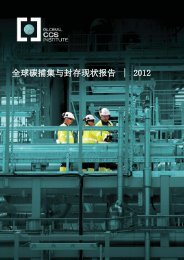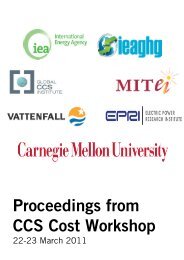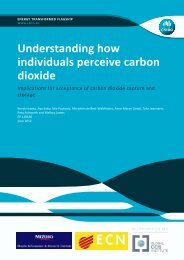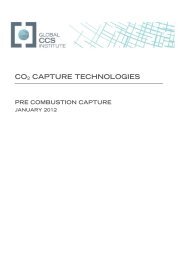Download the document - Global CCS Institute
Download the document - Global CCS Institute
Download the document - Global CCS Institute
- No tags were found...
Create successful ePaper yourself
Turn your PDF publications into a flip-book with our unique Google optimized e-Paper software.
1 Introduction1.1 CO 2 sequestrationThe process of capturing carbon dioxide (CO 2 ) and storing (sequestering) it into deep saline aquifers isbecoming an important method in reducing global atmospheric emissions of CO 2 (e.g. Michael et al.,2009). Aquifers, which are defined as underground layers of water-bearing permeable rock or unconsolidatedmaterials, are chosen (e.g. Doughty et al., 2007; Schilling et al., 2009; JafarGandomi and Curtis,2011) in preference to depleted hydrocarbon reservoirs (e.g. Arts et al., 2004; White and Johnson, 2009),and deep, unmineable coal seams (e.g. Gale and Freund, 2001), primarily because <strong>the</strong>ir potential forCO 2 storage is much greater (IPCC, 2005), but also because of a perception of reduced safety in depletedreservoirs because of poorly-sealed abandoned wells. This report considers only sequestration in salineaquifers. Figure 1.1 illustrates <strong>the</strong> worldwide prospectivity of sedimentary basins for CO 2 sequestration.Figure North American 1.1: Worldwide capacity, oil distribution and gas reservoirs of are sedimentary estimated basins Figure 1and Sedimentary <strong>the</strong>ir prospectivity basins showing suitability for CO as sequestrationto be able to contain ~80 Gt C, saline aquifers between 900sites (IPCC 2005)2 sequestrationand 3300 Gt C, and(aftercoalIPCC,beds about2005).150 Gt C, for a totalof about 1160 to 3500 Gt C (DOE 2007). If <strong>the</strong>se estimatesare correct, <strong>the</strong>re is sufficient capacity to sequester severalMonitoring and verification (M&V) of stored CO remain separate. At conditions expected for sequestration,hundreds of years of emissions. Only time and experience 2 is critical to <strong>the</strong> success of any sequestration projectCO 2 and water are immiscible. Oil and CO 2 may or may not(e.g. will tell JafarGandomi whe<strong>the</strong>r <strong>the</strong>se estimates and Curtis, are correct. 2011). Monitoringbe requires miscible, that depending <strong>the</strong> subsurface on <strong>the</strong> composition distribution of <strong>the</strong> of oil CO and 2In <strong>the</strong> short term, <strong>the</strong> biggest challenge is match sequestrationsites to CO 2 sources. For example, <strong>the</strong> large capacity When <strong>the</strong> fluids are miscible, <strong>the</strong> CO 2 eventually displaces<strong>the</strong> formation pressure. CO 2 and natural gas are miscible.be observed and tracked. Monitoring techniques need to be able to detect when a minimum thresholdin <strong>the</strong> oil and volume gas reservoirs and saturation will only become in COavailable when <strong>the</strong> nearly all of <strong>the</strong> original fluid. Injection of an immiscible2 has been exceeded, ei<strong>the</strong>r within a storage reservoir or without.operator declares <strong>the</strong>m depleted or implements enhanced oil fluid bypasses some fraction of <strong>the</strong> pore space, trappingMonitoringrecovery (EOR)<strong>the</strong>refore,(ARI 2006).isAacomparisondirect driverof sequestrationof <strong>the</strong> storagesome process, of <strong>the</strong> and original mustfluid. be carried With <strong>the</strong> out limited over <strong>the</strong> exception lifetime ofcapacity and emissions indicates that some of <strong>the</strong> greatest dry-gas reservoirs, most sequestration projects will requireof <strong>the</strong> reservoir (Benson et al., 2004).CO 2 emitters (e.g. in <strong>the</strong> Ohio River Valley, India, and parts immiscible displacement to one degree or ano<strong>the</strong>r. Forof China) are located in regions without large sequestration example, although oil and CO 2 are miscible, <strong>the</strong> water thatDespitecapacities.COOn 2 ’s<strong>the</strong>transparencyo<strong>the</strong>r hand, Texas,to most<strong>the</strong>extantUS stategeophysicalwith <strong>the</strong> is methods, almost always <strong>the</strong>re present are many in formations conceivable is not geophysicalmiscible withhighest CO 2 emissions, has extremely large sequestration oil or CO 2 /oil mixtures. Equilibration of CO 2 between oilmeasurements that might be made to map <strong>the</strong> distribution of COcapacity. <strong>CCS</strong> will likely begin in regions with large emissionmeasuring sources, large acoustic sequestration impedance capacity, contrasts and opportunities using a seismicand water depends 2 . We might derive COon <strong>the</strong> composition of 2 distributions<strong>the</strong> oil.byUnder conditionssurvey. Wewheremight<strong>the</strong> fluidderivephasesCOare 2 distributionsnot miscible,for combining CO 2 sequestration and EOR. Beyond that,by <strong>the</strong> pressure needed to inject CO 2 , <strong>the</strong> rate at which <strong>the</strong>particularly measuring <strong>the</strong> differences case of saline in aquifers densityand using coal gravity beds, <strong>the</strong> surveys. Such differences could arise from changes inleading edge of <strong>the</strong> CO 2 plume moves, and <strong>the</strong> fraction ofpressure,scientific foundationsCOand <strong>the</strong> potential risks of large-scale<strong>the</strong> pore space filled with CO 2 are all governed by multiphaseflow relationships (Bear 1972). For CO 2 sequestra-injection must 2 saturation, or both. We might also derive CObe established.2 distributions by measuring changes in conductivityusing electrical or electromagnetic (EM) surveys.tion, threeSuchparticularly measurementsimportanthaveconsequencesformed <strong>the</strong>arise basisfromofaSCIeNTIFIC number of prior FUNDAmeNTAlSstudies (Kazemeini et al., 2010; Giese multiphase et al., 2009; flow behavior. SchillingFirst, et al., <strong>the</strong> 2009; fraction Gasperikovaof <strong>the</strong> poreOF GeOlOGICAl SeqUeSTRATIONspace that can be filled with CO 2 is limited by <strong>the</strong> flowdynamics and capillary pressure resulting from interactionPhysical Properties of CO 2of two or more phases. At most, about 30% of <strong>the</strong> pore space | 1The physical state of CO 2 varies with temperature and pressure,as shown in Figure 4a (Oldenburg 2007). At ambient CO 2 saturation is likely to be even less because of buoyancyis filled with CO 2 during initial displacement. In practice,conditions, CO 2 is a gas, but it becomes liquid at greater and geological heterogeneity, both of which cause portionsdepth. At high temperature, CO 2 is a supercritical fluid of <strong>the</strong> formation to be bypassed. After injection has stopped,when pressure is high enough. The transition from one CO 2 continues to move and fluid saturation approachesstate to ano<strong>the</strong>r depends on <strong>the</strong> geo<strong>the</strong>rmal gradient. In equilibrium, which is determined by <strong>the</strong> capillary pressure
















